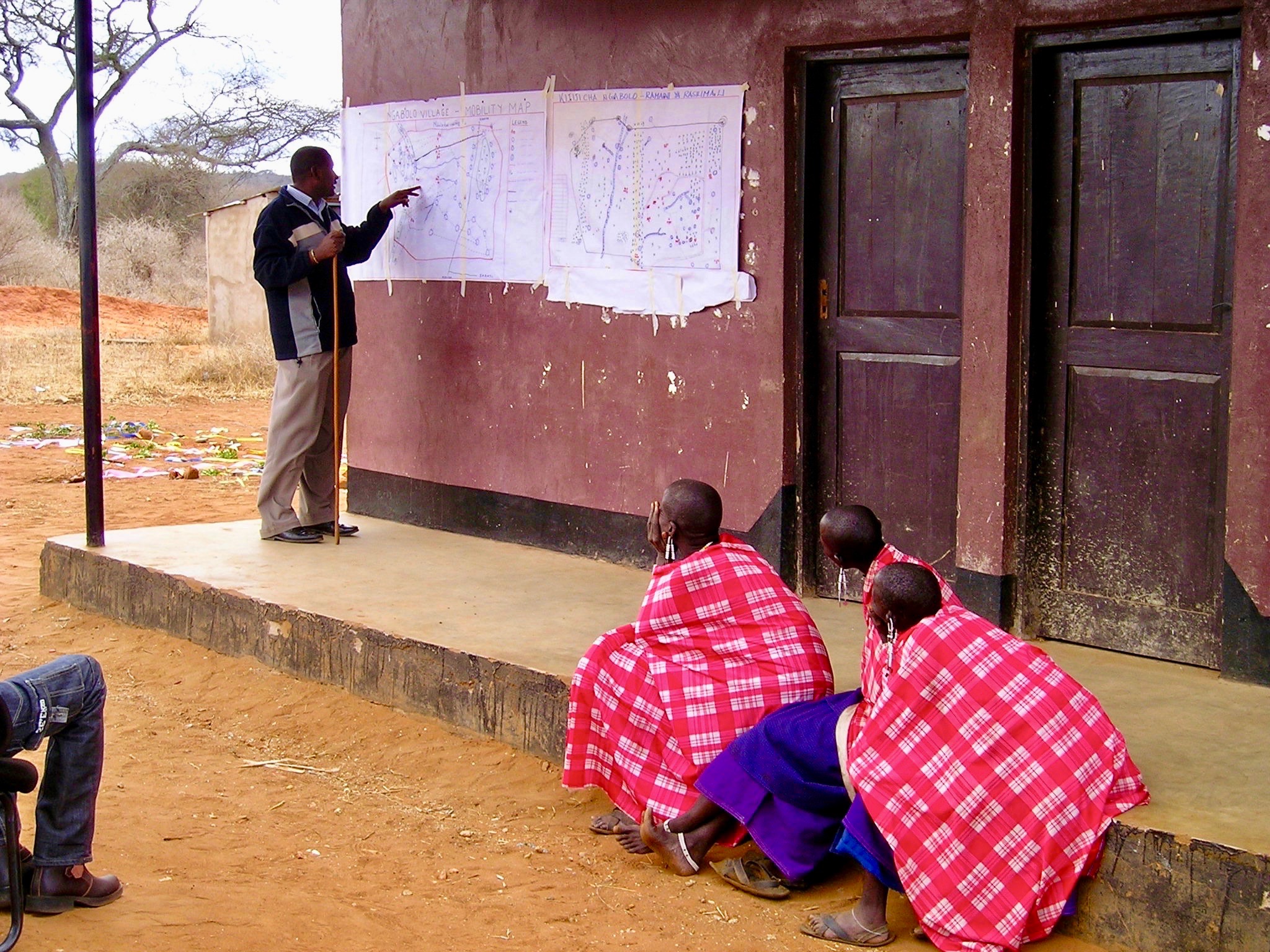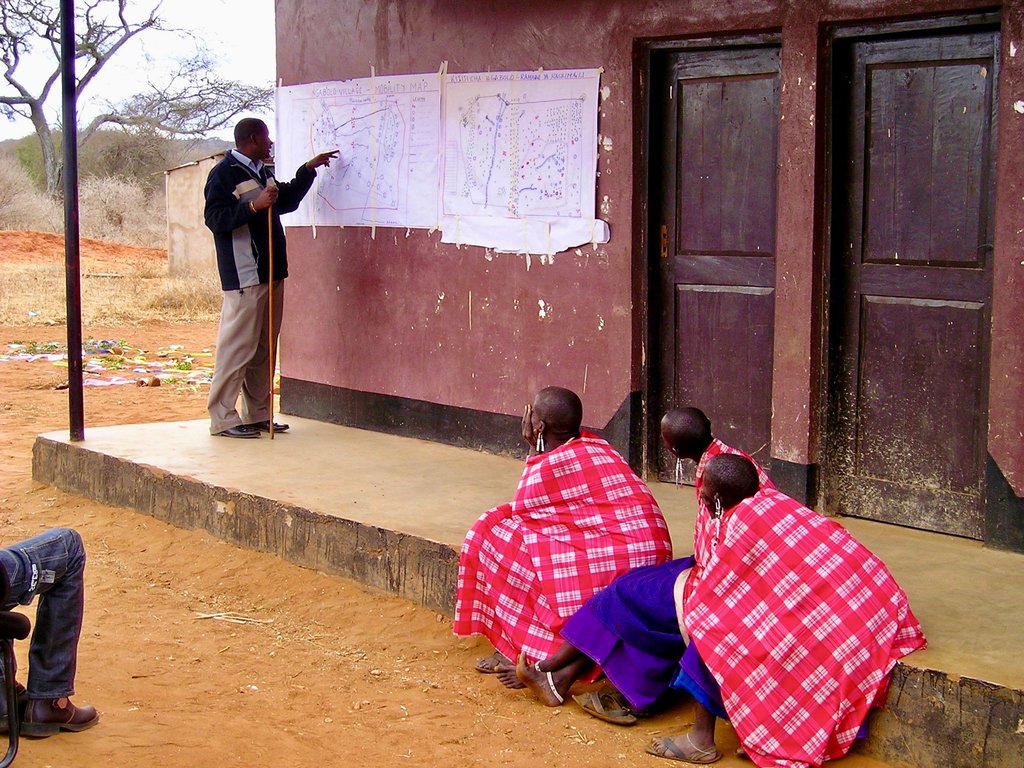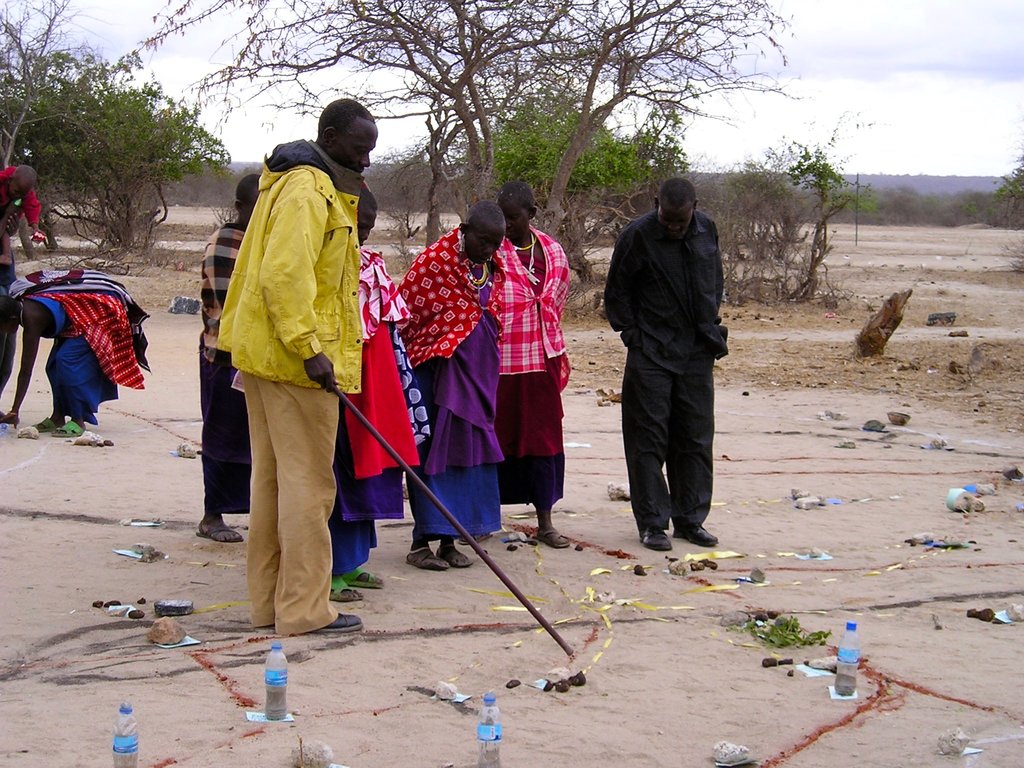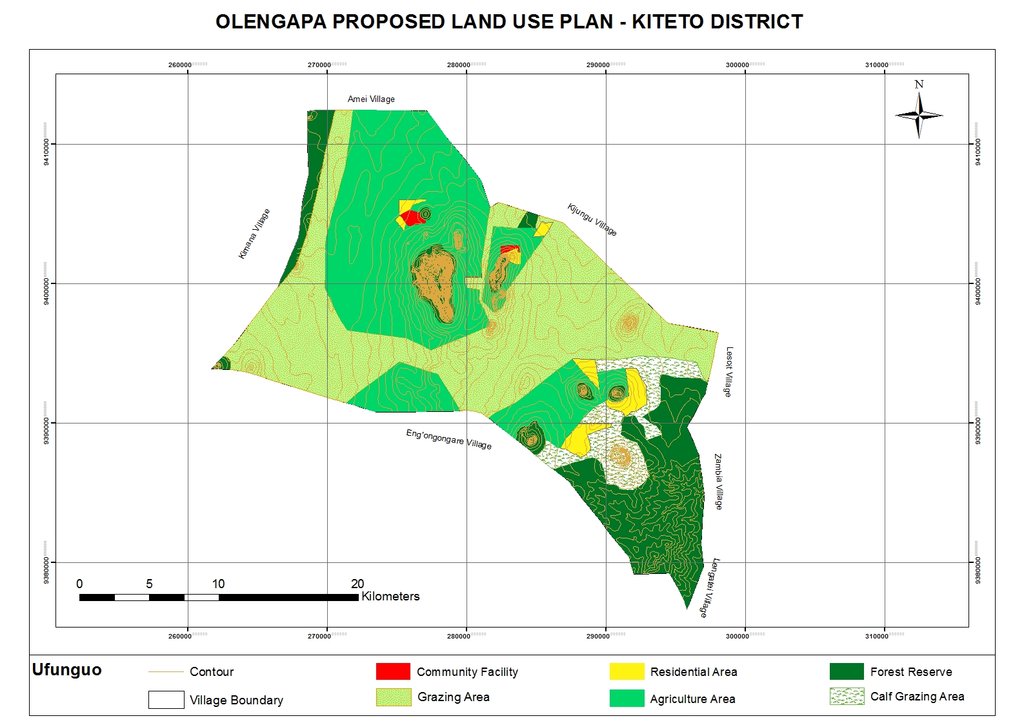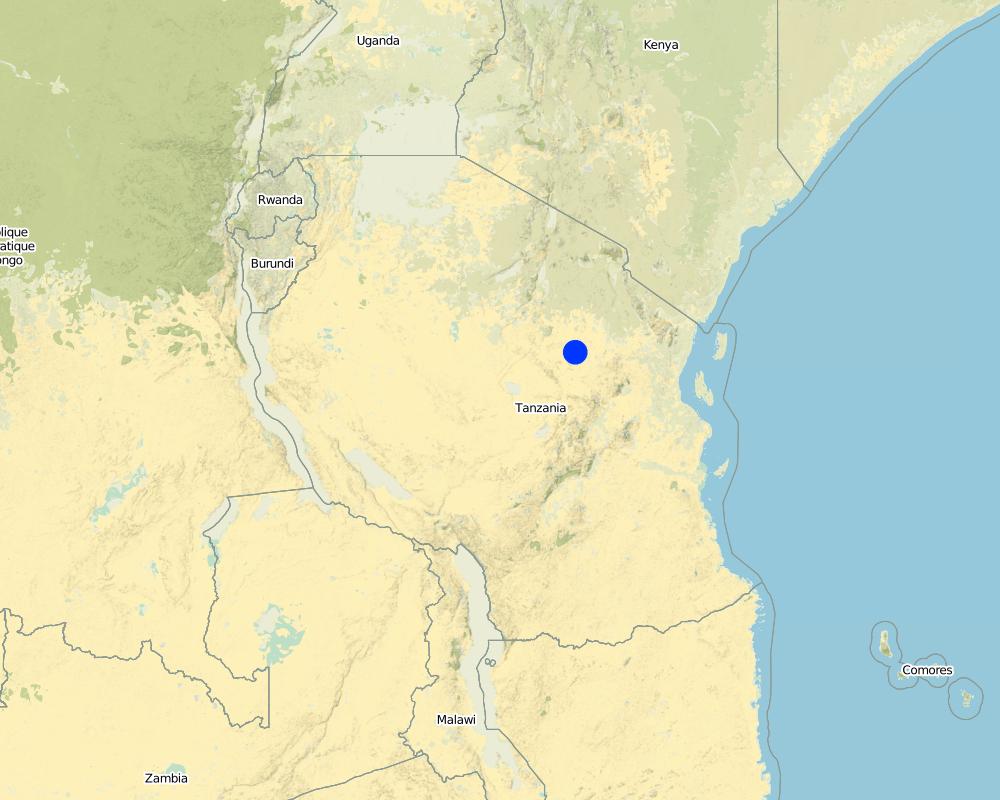Joint village land use planning [坦桑尼亚联合共和国]
- 创建:
- 更新:
- 编制者: Fiona Flintan
- 编辑者: –
- 审查者: Rima Mekdaschi Studer, Simone Verzandvoort
approaches_3336 - 坦桑尼亚联合共和国
查看章节
全部展开 全部收起1. 一般信息
1.2 参与方法评估和文件编制的资源人员和机构的联系方式
有助于对方法进行记录/评估的项目名称(如相关)
Sustainable Rangeland Management Project (ILC / ILRI)有助于对方法进行记录/评估的机构名称(如相关)
ILRI International Livestock Research Institute (ILRI) - 肯尼亚1.3 关于使用通过WOCAT记录的数据的条件
(现场)数据是什么时候汇编的?:
30/11/2016
编制者和关键资源人员接受有关使用通过WOCAT记录数据的条件。:
是
2. SLM方法的描述
2.1 该方法的简要说明
Joint village land use planning is a process facilitated by Tanzania's land policy and legislation. It supports the planning, protection and management of shared resources across village boundaries. It is an important tool towards land use planning and better rangeland management. This case study provides an example from a cluster of villages in Kiteto District, Tanzania.
2.2 该方法的详细说明
该方法的详细说明:
The Sustainable Rangeland Management Project (SRMP) is an initiative led by Tanzania’s Ministry of Livestock and Fisheries (MoLF), the International Livestock Research Institute (ILRI) and the National Land Use Planning Commission (NLUPC), with support from International Fund for Agricultural Development (IFAD), Irish Aid and the International Land Coalition (ILC). A key innovation of the project has been the development of joint village land use planning (JVLUP). The JVLUP process in Kiteto District, Manyara Region began in November 2013, and included the villages of Lerug, Ngapapa, and Orkitikiti. The three villages share boundaries and grazing resources, and in order to illustrate a single shared identity across the boundaries, the name OLENGAPA was chosen - incorporating part of each village’s name.
The total area of the three villages is (approx.) 59,000 hectares. The majority of inhabitants are Maasai pastoralists with some Ndorobo hunter-gatherers, and some farmers - most of whom are seasonal migrants. Mobility is central to the survival of the pastoralists and takes place across the three villages, as well as to locations in Kilindi, Gairo, and Bagamoyo Districts.
Average annual rainfall is between 800-1,000 mm per annum. There are no perennial rivers flowing through the OLENGAPA villages. The only permanent surface water source is Orkitikiti Dam, constructed in 1954.
In order to understand the different resources such as grazing areas, water points, cropping areas, livestock routes, and cultural places, SRMP supported participatory mapping. This assisted in developing a base map for the village land use planning process: it showed which resources were shared by the villages and where they were situated.
SRMP then helped village members to agree the individual village land use maps and plans - which zoned the village land into priority land uses - as well as the joint village land use map and plan, and the joint village land use agreement (JVLUA). These specified the grazing areas, water points, livestock routes and other shared resources. Reaching agreement was a protracted negotiation process between the villages, and within villages also - between different interest groups. It involved numerous community meetings and considerable investment of resources. Finally, each Village Assembly approved the JVLUA, which allocated approx. 20,700 ha of land for shared grazing –around 40% of the total village area. By-laws for management of the resources were developed and adopted.
Following approval of the JVLUA, the three OLENGAPA Village Councils established a Joint Grazing Land Committee made up of members from all three villages. This Committee is responsible for planning, management, enforcement of by-laws applicable to the OLENGAPA, and coordination of the implementation of both the OLENGAPA land use agreements and joint land use plan. In addition, a Livestock Keepers Association was established, including 53 founding members – but with most households from the three villages being associate members. A constitution was developed for the Association, which was officially registered on 11 September 2015.
In January 2016 the Ministry of Lands approved and registered the village land boundary maps and deed plans for the three villages. The District Council has issued the village land certificates, and the next step is for Village Councils to begin issuing Certificates of Customary Rights of Occupancy (CCROs). The shared grazing area will require three group CCROs to be issued to the Livestock Keepers Association – one from each village - for the part of the grazing area that falls under its jurisdiction. Signboards and beacons marking the shared grazing area are being put in place.
In November 2017 a fourth village joined OLENGAPA, expanding the shared grazing area to 30,000 ha. The villages are now working to develop a management plan to improve rangeland productivity.
2.3 该方法的照片
2.5 采用该方法的国家/地区/地点
国家:
坦桑尼亚联合共和国
区域/州/省:
Manyara Region
有关地点的进一步说明:
Kiteto District
注释:
Kiteto District, Manyara Region, Tanzania
Map
×2.6 该方法的开始和终止日期
注明开始年份:
2010
终止年份(若不再采用该方法):
2017
2.7 方法的类型
- 基于项目/方案
2.8 该方法的主要目的/目标
To secure shared grazing areas and other rangeland resources for livestock keepers, and to improve their management.
2.9 推动或妨碍实施本办法所适用的技术的条件
社会/文化/宗教规范和价值观
- 启动
History of collective tenure, management and sharing of rangeland resources as part of sustainable rangeland management practices.
- 阻碍
Marginalisation of pastoralists from decision-making processes at local and higher levels.
财务资源和服务的可用性/可得性
- 阻碍
Village land use planning process is costly due to the requirement to include government experts in the process in order to gather required data and to authorise plans. Lack of government priority to village land use planning, so poor allocation of government funds to the process.
机构设置
- 启动
Strong local government/community institutions for leading process at local albeit their capacity may require building.
参与者的的协作/协调
- 阻碍
Poor coordination of different actors supporting VLUP in the past due to previous weakness of National Land Use Planning Commission (NLUPC). However, this is now changing as NLUPC becomes stronger and takes up coordination role.
法律框架(土地使用权、土地和水使用权)
- 启动
Tanzania's legislation, if implemented well, provides an enabling environment for securing of community/village rights for both individuals and groups.
- 阻碍
Legislation allows village land to be transferred into public land if in the "public" or "national" interest - this facility confers insecurity on village land.
政策
- 启动
Tanzania possesses facilitating national land use policy for the joint village land use planning approach, together with guidelines.
- 阻碍
There are conflicting policies over land coming from different sectors including land generally, together with forests, wildlife and livestock. These cause confusion at the local level. Depending on power of actors one set of policies may be stronger than another - wildlife-related policy for example can have a lot of power because there are many strong and influential tourism and conservation bodies lobbying for stronger protection of land, with potentially negative impacts for communities who want to use that land for other purposes.
土地治理(决策、实施和执行)
- 启动
Decision-making has been decentralised to the lowest levels, giving local communities considerable power to decide on the uses of their village land.
- 阻碍
The process of village land use planning is costly due to the requirement for having local government experts involved, and the need to follow often complex procedures and steps. Many communities and even local government do not have adequate technical skills and knowledge to complete the long process, as well as not having adequate funds. This has held up the VLUP applications. Further few VLUPs move from their production stage to implementation stage including enforcement of bylaws and, for example, land management.
了解SLM,获得技术支持
- 启动
Good local knowledge of rangeland management based on historical practice. Communities understand need for better rangeland management.
- 阻碍
Lack of investment in rangeland management and the provision of technical support e.g. through government extension services. Lack of technical knowledge in rangeland rehabilitation and improving rangeland productivity at scale.
市场(购买投入,销售产品)和价格
- 阻碍
Lack of local markets and coordinated operations for livestock production.
工作量、人力资源可用性
- 启动
Well-structured local community bodies ready to provide manpower. Local government experts in place to support VLUP process.
- 阻碍
Lack of knowledge, skills and capacity amongst local communities and government experts to complete JVLUP adequately, including such as resolving conflicts between different land users.
3. 相关利益相关者的参与和角色
3.1 该方法涉及的利益相关者及其职责
- 当地土地使用者/当地社区
Village members (Assembly) of three villages - Orikitiki, Lerug and Ngapapa.
All village members as the Village Assembly have an opportunity to contribute to the land use planning process and to approve it.
- 社区组织
Village Council, Village Land Use Management Committee (VLUMC), Rangeland Management Committee, Livestock Keepers Association.
Village government coordinated the planning process at local level. VLUMC develops plan. Village Council approves plans and issues CCROs. Rangeland Management Committee oversees development in rangelands. Livestock Keepers Association established made-up of all members of the villages that have livestock (nearly all village members) - they will be issued with CCROs as "owners" of the grazing land.
- SLM专家/农业顾问
Land use planning consultants
Provision of advice to the project team, local government and villagers on the JVLUP approach.
- 研究人员
International Livestock Research Institute (ILRI)
Identification of good practice in village land use planning in Tanzania and ways to adapt and incorporate good practice into joint village land use planning to improve the approach. Research on role of and impact on pastoral women. Undertaking of baseline studies.
- NGO
KINNAPA Development Association (supported originally by CARE and Tanzania Natural Resource Forum).
KINNAPA is the local CSO partner working as part of the project to implement the JVLUP with local communities
- 地方政府
District Council including the PLUM (participatory land use management planning experts)
The District Council provides local government oversight of the planning process and approves the plan before submitting to national government body. The PLUM technically supports the development of the JVLUP working with the village government(s) and village committees.
- 国家政府(规划者、决策者)
Ministry of Livestock and Fisheries, National Land Use Planning Commission (NLUPC), Ministry of Lands, Housing and Human Settlements Development,
Ministry of Livestock and Fisheries leading the planning process with a sectoral interest in protecting rangelands. NLUPC provides technical oversight and guidance. Ministry of Lands is the national body that approves the final plan.
- 国际组织
International Land Coalition (ILC)
ILC is the grant recipient for the funds from the donors. The project is implemented through ILC members such as ILRI. ILC coordinates its members work in Tanzania on land issues including the JVLUP through a national engagement strategy (NES). ILC also provides technical support to the process through its global/Africa programme - the ILC Rangelands Initiative. The ILC Rangelands Initiative is a platform for learning, sharing, influencing, and connecting on rangeland issues with the objective of making rangelands more secure.
- Donors
IFAD and Irish Aid
Provide funds for the project. IFAD also provides technical support on land tenure issues.
如果涉及多个利益相关者,请注明领导机构:
The lead agency is the International Land Coalition (ILC) working through its members including ILRI. In country, the main implementer is the Ministry of Livestock and Fisheries
3.2 当地土地使用者/当地社区参与该方法的不同阶段
| 当地土地使用者/当地社区的参与 | 指定参与人员并描述活动 | |
|---|---|---|
| 启动/动机 | 外部支持 | The project supported communities to initiate the first steps taken to reach agreement on the need for planning and how this would be done. |
| 计划 | 互动 | Communities were centrally involved in the planning of the VLUP process, with support from local NGO and government. |
| 实施 | 互动 | Village government and community in general is responsible for the implementation of the planning process, with the support of local government. |
| 监测/评估 | 外部支持 | The community is responsible for monitoring and evaluation, but lack skills and capacity in this regard requiring external support. |
| Research | 外部支持 | Research on information required for planning processes collected and generated by communities with the assistance of technical support from local NGO, local government and researchers. |
3.3 流程图(如可用)
3.4 有关SLM技术选择的决策
具体说明谁有权决定选择要实施的技术:
- 所有相关参与者,作为参与式方法的一部分
解释:
The policy and legislation lays down the steps to be followed for the VLUP/JVLUP process. However there is room to adapt these processes to local context - and here all stakeholders were involved to develop the process of JVLUP through its first piloting. This included communities, local and national government, local NGOs, researchers and development organisations.
明确做出决策的依据:
- 对充分记录的SLM知识进行评估(基于证据的决策)
4. 技术支持、能力建设和知识管理
4.1 能力建设/培训
是否为土地使用者/其他利益相关者提供培训?:
是
明确受训人员:
- 土地使用者
- 现场工作人员/顾问
- government staff
培训形式:
- 在职
- 公开会议
- 课程
涵盖的主题:
Land users were trained in land related and other relevant laws and the JVLUP process. Field staff/advisers were trained in land laws, the JVLUP process, gender, and conflict resolution. Local government were trained in the JVLUP process, gender and conflict resolution.
4.2 咨询服务
土地使用者有权使用咨询服务吗?:
否
4.3 机构强化(组织发展)
是否通过这种方法建立或加强了机构?:
- 是,非常
具体说明机构的强化或建立程度:
- 本地
- 国家
说明机构、角色和职责、成员等。:
Local government bodies including Village Council, VLUMC (village land use management committee) and Livestock Keepers Association have all had capacity strengthened, but more is required (particularly for the latter). Capacity of the Ministry of Livestock and Fisheries and the National Land Use Planning Commission to implement JVLUP has been built.
具体说明支持类型:
- 财务
- 能力建设/培训
- 设备
- data collected and database set up
4.4 监测和评估
监测和评估是该方法的一部分吗?:
是
注释:
M&E has not been strong in previous phases, but now is central with baselines being carried out in all new clusters of villages where the project will work so that impact can be fully assessed.
若是,该文件是否用于监测和评估?:
否
4.5 研究
研究是该方法的一部分吗?
是
明确话题:
- 社会学
- 经济/市场营销
- 生态学
提供进一步的细节,并指出是谁做的研究:
Research was carried out to identify good practice (in terms of social, economic and environmental impacts) from which the JVLUP process was developed. In future phases the full impacts of this JVLUP in terms of social, economic and ecological impact are being researched.
5. 融资和外部物质支持
5.1 该方法中SLM组成部分的年度预算
如果不知道准确的年度预算,请给出一个范围:
- 10,000-100,000
注释(例如主要的资助来源/主要捐助者):
IFAD, Irish Aid,
5.2 为土地使用者提供财政/物质支援
土地使用者是否获得实施该技术的财政/物质支持?:
否
5.3 对特定投入的补贴(包括劳动力)
- 无
如果土地使用者的劳动力是一项重要的投入,那么是不是:
- 自愿
注释:
Labour was voluntary with meal provided and/or travel costs covered.
5.4 信用
是否根据SLM活动的方法给予信用值?:
否
5.5 其它激励或手段
是否有其他激励措施或工具用于促进SLM技术的实施?:
是
如果是,请具体说明:
Tanzanian policy and legislation states that all village should have a VLUP, therefore this was an incentive for stakeholders to invest in the process. In addition conflicts over land use are increasingly a problem in Tanzania - so the resolution of these was also an important incentive.
6. 影响分析和结论性陈述
6.1 方法的影响
该方法是否有助于当地土地使用者,提高利益相关者的参与度?:
- 否
- 是,很少
- 是,中等
- 是,支持力度很大
Local village communities now feel strongly empowered in protecting and managing their land. The process has brought different stakeholders together and strengthened commitment to make the process work.
这种方法是否有助于基于证据的决策?:
- 否
- 是,很少
- 是,中等
- 是,支持力度很大
The piloting of the JVLUP showed what is possible and the positive impacts realised (albeit they could have been better documented). On these results the process is being scaled-up.
该方法是否帮助土地使用者实施和维护SLM技术?:
- 否
- 是,很少
- 是,中等
- 是,支持力度很大
The planning process has laid the foundations for improved rangeland management - what is now required is investment in that management.
该方法是否提高了SLM的协调性和成本效益?:
- 否
- 是,很少
- 是,中等
- 是,支持力度很大
The JVLUP established the structures for coordination of management across the village boundaries - what is now required is investment in that management. It is believed that the approach of planning across village boundaries and jointly is more cost-effective than planning separately - but the evidence of this needs to be fully documented.
该方法是否调动/改善了使用财务资源实施SLM的途径?:
- 否
- 是,很少
- 是,中等
- 是,支持力度很大
By helping communities to establish a Livestock Keepers Association there is potential there for the Association to access funds for development through government structures, but this has not happened yet.
该方法是否提高了土地使用者实施土地管理的知识和能力?:
- 否
- 是,很少
- 是,中等
- 是,支持力度很大
Land users have greater knowledge of the potential and need for rangeland management based on a better understanding of their land and resources gained through the JVLUP process, but they still need skills and resources to put this knowledge into action.
该方法是否提高了其他利益相关者的知识和能力?:
- 否
- 是,很少
- 是,中等
- 是,支持力度很大
National and local government have seen the potential of the JVLUP to resolve conflicts over land use, and their capacities to implement the JVLUP in this regard has been improved.
该方法是否建立/加强了机构、利益相关者之间的合作?:
- 否
- 是,很少
- 是,中等
- 是,支持力度很大
The approach is helping build relations between the Ministry Livestock and Fisheries and the NLUPC together with NGO(s) at national level, as well as between different stakeholders involved in JVLUP at local levels.
该方法是否缓解了冲突?:
- 否
- 是,很少
- 是,中等
- 是,支持力度很大
Through the process of JVLUP the roots of land use conflicts come to the surface and must be resolved before agreement is reached. This may cause tensions and even conflict along the way - but the outcome should be positive.
该方法是否有助于社会和经济弱势群体?:
- 否
- 是,很少
- 是,中等
- 是,支持力度很大
Pastoralists are often left out of village land use planning processes. This approach when implemented well gives greater opportunity for them to be involved. However this is still a challenge.
该方法是否改善了性别平等并赋予女性权力?:
- 否
- 是,很少
- 是,中等
- 是,支持力度很大
Women can be left out of village land use planning processes. This approach when implemented well gives greater opportunity for them to be involved. However this is still a challenge.
该方法是否鼓励年轻人/下一代土地使用者参与SLM?:
- 否
- 是,很少
- 是,中等
- 是,支持力度很大
Youth can be left out of village land use planning processes. This approach when implemented well gives greater opportunity for them to be involved. However this is still a challenge.
该方法是否改善了阻碍SLM技术实施的土地使用权/用户权问题?:
- 否
- 是,很少
- 是,中等
- 是,支持力度很大
By following the JVLUP process village land has been certified and secured, as well as the rights of access and use of livestock keepers to the grazing land.
该方法是否改善了粮食安全/改善了营养?:
- 否
- 是,很少
- 是,中等
- 是,支持力度很大
This has not been specifically monitored but it assumed by having stronger security to land and resources, food security and nutrition will be improved.
该方法是否改善了市场准入?:
- 否
- 是,很少
- 是,中等
- 是,支持力度很大
This has not been specifically monitored but it assumed by having stronger security to land and resources, access to markets will be improved.
该方法是否改善了供水和卫生条件?:
- 否
- 是,很少
- 是,中等
- 是,支持力度很大
In terms of water for livestock the JVLUP process has secured rights for the three villages to shared water resources.
该方法是否带来了更可持续的能源使用?:
- 否
- 是,很少
- 是,中等
- 是,支持力度很大
该方法是否提高了土地使用者适应气候变化/极端情况和减轻气候相关灾害的能力?:
- 否
- 是,很少
- 是,中等
- 是,支持力度很大
By having stronger security to land and resources local land users are better placed to adapt to climate change etc.
该方法是否会带来就业、收入机会?:
- 否
- 是,很少
- 是,中等
- 是,支持力度很大
This has not been specifically monitored but it assumed by having stronger security to land and resources, income opportunities will be improved.
6.2 土地使用者实施SLM的主要动机
- 增加生产
By protecting grazing areas, there will be more secure access to resources required for livestock production.
- 减少土地退化
By protecting grazing areas and improvement of rangeland management practices land degradation will be reduced.
- 降低灾害风险
With more secure access to land and resources, local land users are better placed to manage their resources in order to reduce risks to disasters.
- 规章制度(罚款)/执行
By gaining protection from village certification, village land use planning and local bylaws developed as part of this, local land users are better placed to enforce rules and regulations relating to land use and to prevent encroachment/trespassing by outsiders.
- 声望、社会压力/社会凝聚
The JVLUP process improved the social cohesion and group identify of the three villages - expressed in the name OLENGAPA (made up of the three village names). There is a strong livestock keepers association now made up of livestock keepers from all three villages who are working more closely together.
- 冲突缓解
The JVLUP helped to resolve land use conflicts by opening up space to discuss root causes, find solutions and come to agreement between land users.
6.3 方法活动的可持续性
土地使用者能否维持通过该方法实施的措施(无外部支持的情况下)?:
- 不确定
若否或不确定,请具体说明并予以注释:
The community requires support from local government to protect their village lands including grazing lands from outsiders wanting to settle on the land - this is a constant problem to be addressed (despite the securing of village boundaries etc.). The community also needs capacity building and resources to improve the productivity of the land including the grazing areas. If they get these supports then they can sustain what has been implemented.
6.4 该方法的长处/优点
| 土地使用者眼中的长处/优势/机会 |
|---|
| Improved the security of access and use to village land including grazing. |
| Brought attention to the challenges faced by land users in the area in protecting and using their village land, and the need for more investment and support for this. |
| Pastoralists are now more central to decision-making processes than they were before. |
| 编制者或其他关键资源人员认为的长处/优势/机会 |
|---|
| Collaboration of different stakeholders in implementing the approach has supported a new way of working. |
| Capacity of different stakeholders has been built along the way through joint problem-solving and learning-by-doing. |
| The approach - with adaptation - has application in other contexts/countries and shows that even if a rangeland is split by administrative boundaries there is opportunity to work across those village boundaries in order to maintain the functionality of the rangeland and land use systems such as pastoralism that depend upon this. |
6.5 该方法的弱点/缺点以及克服它们的方法
| 土地使用者认为的弱点/缺点/风险 | 如何克服它们? |
|---|---|
| Despite village land being theoretically protected, in practice it can still be encroached upon. | Greater support provided from government to enforce protection of land. |
| Time-consuming process which became more expensive than anticipated resulting in some gaps in funding. | Process needs to be refined through practice, and adequate funds allocated from beginning. |
| 编制者或其他关键资源人员认为的弱点/缺点/风险 | 如何克服它们? |
|---|---|
| The selection of villages for JVLUP needs more care to ensure that enabling conditions for JVLUP exist. | In future selection of villages for JVLUP a set of criteria should be used that enable more enabling conditions to exist. |
| Information has not been methodologically collected on social, environmental and economic impacts of the approach. | In future the impacts of the approach need to be fully monitored and evaluated. |
| The VLUP is an expensive process to follow. | National government needs to identify ways to reduce the cost of the VLUP so that more villages can undertake it. Government needs to allocate more funds to VLUP. The VLUP is an expensive process to follow. |
| Need for an enabling environment. | The policy and legislation in Tanzania enables this process - it is not the case in the majority of other African countries. |
7. 参考和链接
7.1 方法/信息来源
- 根据报告和其他现有文档进行编译
The compiler has been involved in the project/process since its inception and had access to all reports and existing documentation.
7.3 链接到网络上可用的相关信息
标题/说明:
Kalenzi, D. 2016. Improving the implementation of land policy and legislation in pastoral areas of Tanzania: Experiences of joint village land use agreements and planning. Rangelands 7. Rome, Italy: International Land Coalition.
URL:
https://cgspace.cgiar.org/handle/10568/79796
标题/说明:
Daley, E., Kisambu, N. and Flintan, F. 2017. Rangelands: Securing pastoral women’s land rights in Tanzania. Rangelands Research Report 1. Nairobi, Kenya: ILRI.
URL:
https://cgspace.cgiar.org/handle/10568/89483
标题/说明:
International Livestock Research Institute. 2017. Sustainable Rangeland Management Project, Tanzania. ILRI Project Brochure. Nairobi, Kenya: ILRI.
URL:
https://cgspace.cgiar.org/handle/10568/80673
标题/说明:
International Land Coalition. 2014. Participatory rangeland resource mapping in Tanzania: A field manual to support planning and management in rangelands including in village land use planning. Rome: International Land Coalition
URL:
https://cgspace.cgiar.org/handle/10568/51348
标题/说明:
Flintan, F., Mashingo, M., Said, M. and Kifugo, S.C. 2014. Developing a national map of livestock routes in Tanzania in order to value service and protect them. Poster prepared for the ILRI@40 Workshop, Addis Ababa, 7 November 2014. Nairobi, Kenya: ILRI.
URL:
https://cgspace.cgiar.org/handle/10568/64964
标题/说明:
Village land use planning in rangelands in Tanzania, F. Flintan 2012
URL:
http://www.landcoalition.org/en/regions/africa/resources/no-3-village-land-use-planning-rangelands-tanzania
标题/说明:
Protecting shared grazing through joint village land use planning
URL:
http://www.landcoalition.org/en/regions/africa/resources/protecting-shared-grazing-through-joint-village-land-use-planning
链接和模块
全部展开 全部收起链接
无链接
模块
无模块


